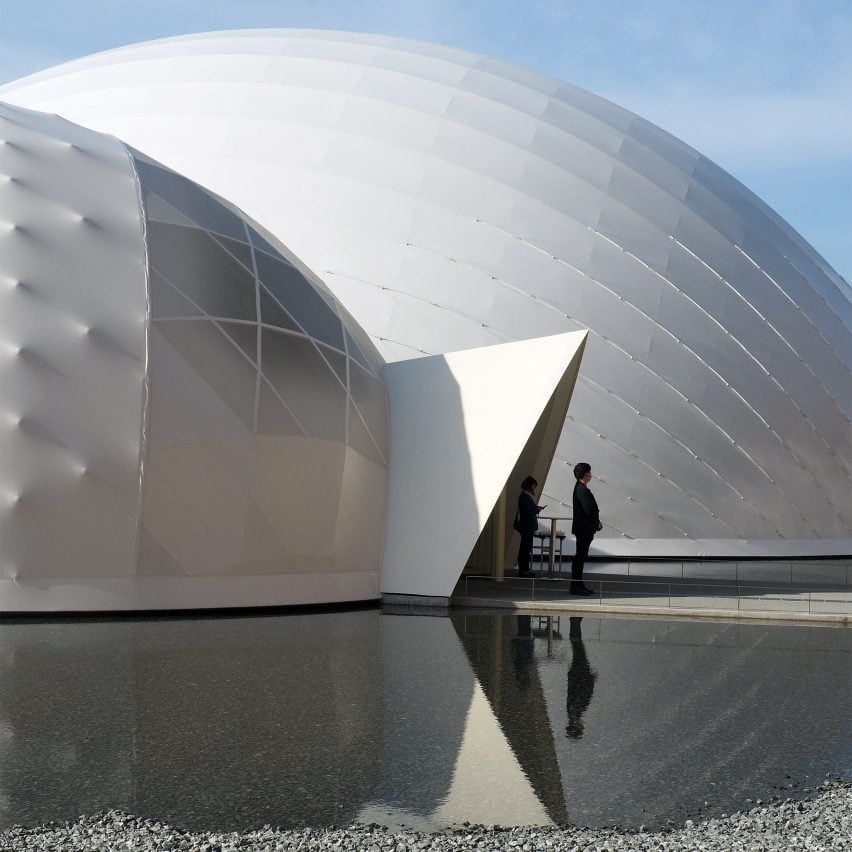Pavilions designed by leading Japanese architects Kengo Kuma, Shigeru Ban and SANAA feature in this preview of 10 must-see pavilions at Expo 2025 Osaka, which opens this weekend.
Taking place on the artificial island Yumeshima in Osaka Bay, the upcoming World Expo centres on the theme titled Designing Future Society for Our Lives.
A total of 158 countries are exhibiting at the event, alongside pavilions and installations contributed by international organisations, groups and companies.
Read on for stand-out structures at Expo 2025 Osaka:

Bahrain Pavilion by Lina Ghotmeh
Wood was a commonly used material for this year’s expo pavilions. Lebanese architect Lina Ghotmeh modelled the Bahrain Pavilion on the traditional Bahraini dhow – a type of boat once used to transport heavy goods around the coasts of eastern Arabia and east Africa.
According to the architect, the pavilion celebrates Bahrain’s maritime and port history while also nodding to Japanese wood craftsmanship.

Qatar Pavilion by Kengo Kuma
Japanese architect Kengo Kuma was the mastermind behind the Qatar Pavilion, which contains exhibits by Dutch studio OMA.
It has a wooden structure shrouded in taut white fabric. Similarly to Bahrain’s pavilion, it references traditional dhow boats while also paying homage to Japanese joinery.
Kuma is also the architect behind Portugal’s pavilion, which is wrapped in ropes that sway with the wind, representing the country’s maritime heritage – the focus of its exhibits.

Saudi Arabia Pavilion by Foster + Partners
UK studio Foster + Partners based its design of the Saudi Arabia pavilion on the kingdom’s traditional villages.
It is formed of a series of angular volumes linked by narrow walkways that envelop a central courtyard. Access is gained by a forecourt lined with native Saudi Arabian plants.
Inside are a series of audio-visual installations by 59 Productions and Squint/Opera that aim to immerse visitors in “a spatial experience that echoes the exploration of Saudi Arabian towns and cities”.

The Ocean Dome by Shigeru Ban
A trio of domes make up this pavilion by Shigeru Ban – one of which is constructed from his signature paper tubes. Another is built from bamboo, while the third is constructed from carbon-fibre-reinforced plastic.
Commissioned by a non-profit organisation called Zero Emissions Research and Initiatives (ZERI), the exhibits highlight the value of the world’s oceans and how they are being polluted by human activity.

Uzbekistan Pavilion by Atelier Brückner
Occupying one of the smallest plots at the expo is the Uzbekistan Pavilion, designed by German studio Atelier Brückner with the Uzbekistan Art and Culture Development Foundation.
The structure comprises two levels – one wrapped in reclaimed bricks representing the earth and another formed of a cluster of wooden columns to evoke trees. This aligns with its theme, called Garden of Knowledge: A Laboratory for a Future Society.

The Netherlands Pavilion by RAU Architects
A giant glowing orb is the centrepiece of the demountable Netherlands Pavilion by RAU Architects, which is enclosed by a rippling, slatted facade representing water – the focus of the exhibit.
The pavilion explores the Netherlands’ relationship to water, particularly in the face of climate change and rising sea levels. Miniature versions of the orb are given to visitors upon entry, lighting up and responding to the exhibits as they explore.

Japan Pavilion by Nikken Sekkei
Japan’s own pavilion has been designed by Tokyo firm Nikken Sekkei in collaboration with Nendo founder Oki Sato.
Positioned just outside of The Grand Ring, the pavilion is formed of circles of cross-laminated timber, between which exhibits are dotted. After the Expo, it will be disassembled, with its components reused across Japan.

Better Co-being by SANAA and Hiroaki Miyata
An ethereal canopy by SANAA can be found hidden amongst trees in the Forest of Tranquility, which sits at the heart of the Expo 2025 Osaka.
Designed with researcher Hiroaki Miyata, the gridded structure is built from steel and designed without roofs or walls, intended to emulate clouds over the trees.

Switzerland Pavilion by Manuel Herz Architects
Lightweight, spherical structures clad in plastic cascade down the facade of the Switzerland Pavilion, designed by Manuel Herz Architects.
According to the studio, it represents “a building that is embedded in nature”, aiming to showcase how natural and man-made worlds can coexist.

France Pavilion by Coldefy & Associés and Carlo Ratti Associati
A huge spiral staircase clad in copper-coloured panels marks the facade of the France Pavilion, which Coldefy & Associés has designed in collaboration with Carlo Ratti Associati.
The pavilion is designed to represent the theme of love and the staircase is a nod to Akai Ito – a Japanese legend that suggests people who are destined to meet are tied by an unbreakable red string.
The photography is by Lizzie Crook unless stated otherwise.
Expo 2025 will take place in Osaka from 13 April 2025 to 13 October 2025. For more fairs, events and talks in architecture and design visit Dezeen Events Guide.
The post Ten stand-out pavilions at Expo 2025 Osaka appeared first on Dezeen.

